Welcome to
The de Havilland Aircraft
Association of South Africa
The de Havilland Aircraft
Association of South Africa
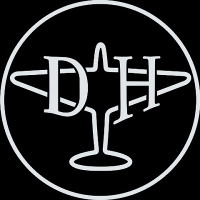
de Havilland's First 25 Years in Southern Africa
1930-1955
1930-1955
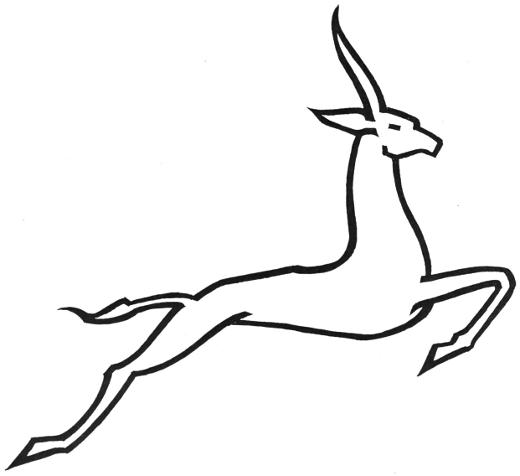
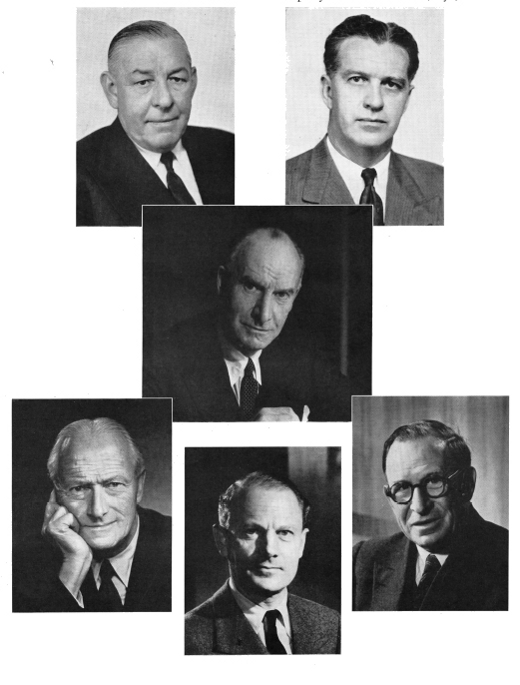
Colonel Rod Douglas
Mr. Jack Davison
Sir Geoffrey de Havilland
Mr. F. T. Hearle
Mr. W. E. Nixon
Mr. F. E. N. St. Barbe
The Directors of the de Havilland Aircraft Company of South Africa (Pty.) Limited
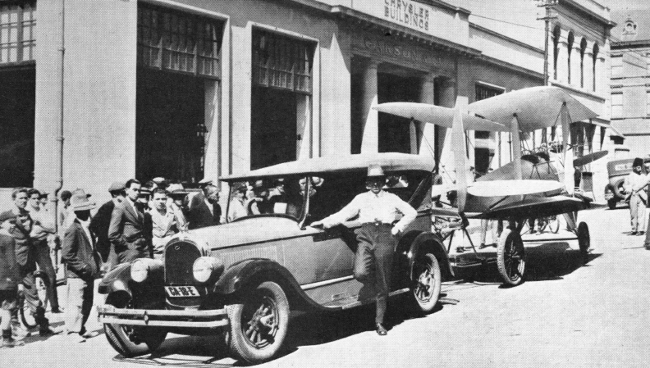
Major "Mac" Miller made a historic flight round the Union of South Africa in the first Moth ever to be imported there. In this photograph he is seen with his aircraft which was towed through the streets of Cape Town without causing any obstruction to the traffic.
WITH the pride of shared endeavour, South African aviation will mark up a quarter of a century to the de Havilland Aircraft Company of South Africa (Pty.) Limited in September this year. Flying history in the Union is closely inter-linked with the Company's record of achievement and, even prior to its formation, with the tradition of de Havilland products. Ever since those bygone days of hazardous air adventure when a D.H.9, appropriately named "The Voortrekker," completed the last leg of that first trail blazed between England and the Cape, de Havilland aircraft, de Havilland engines and de Havilland propellers have been used to write important chapters of air history across the skyways of Southern Africa.
It was de Havilland enterprise that first fired South Africa's air-mindedness in the 'twenties, setting it off on the light aeroplane movement that in less than another decade brought flying within the reach of the ordinary man. Economically successful commercial aviation was introduced into the Union by the de Havilland Moths — Puss Moths, Fox Moths and Leopard Moths. Tiger Moths played their part with de Havilland South Africa in its great role of pioneering and conducting large-scale air training to swell the ranks of the South African Air Force in World War II. The de Havilland Dove heralded post-war civil aviation throughout the continent of Africa. The Comet and Vampire brought in the new age of jet propulsion.
It is a far cry, from these days of "faster than sound," back to that first Board Meeting on September 13, twenty-five years ago, when a handful of flying enthusiasts met in Johannesburg to launch the new company. Rod Douglas took the Chair that day and in addition to himself the first Directors appointed were G. S. Haggie, S. S. Halse and, from the parent Company, Capt. Geoffrey de Havilland and A. S. Butler, who were represented in South Africa by N. H. Gilfillan. Jack Davison — who has risen to become the Company's present Managing Director — attended that historic meeting and in his minutes recorded the arrival of the first Puss Moth into the country. Among those present there was great faith in the future, and almost unbounded optimism that already had its roots, back in England, in that intangible stuff out of which aircraft companies are built - reputation, experience, popularity, initiative and drive.
At that time the merit of de Havilland products was already proven and widely recognised in South African flying circles. Linked with those famous names of an earlier day — such as Sir Pierre van Ryneveld and Sir Quentin Brand, Frank and Shirley Solomon, Major "Mac" Miller, Cobham, Bentley, Lady Bailey and Stan Halse — were equally famous de Havilland types of aircraft. First things had come very much first in laying the foundations for rapid expansion in aviation. Van Ryneveld's inaugural flight was soon followed by Cobham's first return flight (D.H.50), Bentley's first solo flight from England in a light aeroplane (D.H. Moth), the first woman (Lady Bailey) to fly out solo (D.H. Moth), the first flight from England in a light plane carrying a passenger by Capt. and Mrs. Halse (Gipsy Moth). Then there was the first experimental service operated by the South African Air Force for three months between Durban and Cape Town, with D.H.9's.
It was de Havilland enterprise that first fired South Africa's air-mindedness in the 'twenties, setting it off on the light aeroplane movement that in less than another decade brought flying within the reach of the ordinary man. Economically successful commercial aviation was introduced into the Union by the de Havilland Moths — Puss Moths, Fox Moths and Leopard Moths. Tiger Moths played their part with de Havilland South Africa in its great role of pioneering and conducting large-scale air training to swell the ranks of the South African Air Force in World War II. The de Havilland Dove heralded post-war civil aviation throughout the continent of Africa. The Comet and Vampire brought in the new age of jet propulsion.
It is a far cry, from these days of "faster than sound," back to that first Board Meeting on September 13, twenty-five years ago, when a handful of flying enthusiasts met in Johannesburg to launch the new company. Rod Douglas took the Chair that day and in addition to himself the first Directors appointed were G. S. Haggie, S. S. Halse and, from the parent Company, Capt. Geoffrey de Havilland and A. S. Butler, who were represented in South Africa by N. H. Gilfillan. Jack Davison — who has risen to become the Company's present Managing Director — attended that historic meeting and in his minutes recorded the arrival of the first Puss Moth into the country. Among those present there was great faith in the future, and almost unbounded optimism that already had its roots, back in England, in that intangible stuff out of which aircraft companies are built - reputation, experience, popularity, initiative and drive.
At that time the merit of de Havilland products was already proven and widely recognised in South African flying circles. Linked with those famous names of an earlier day — such as Sir Pierre van Ryneveld and Sir Quentin Brand, Frank and Shirley Solomon, Major "Mac" Miller, Cobham, Bentley, Lady Bailey and Stan Halse — were equally famous de Havilland types of aircraft. First things had come very much first in laying the foundations for rapid expansion in aviation. Van Ryneveld's inaugural flight was soon followed by Cobham's first return flight (D.H.50), Bentley's first solo flight from England in a light aeroplane (D.H. Moth), the first woman (Lady Bailey) to fly out solo (D.H. Moth), the first flight from England in a light plane carrying a passenger by Capt. and Mrs. Halse (Gipsy Moth). Then there was the first experimental service operated by the South African Air Force for three months between Durban and Cape Town, with D.H.9's.
There was " Mac " Miller's historic flight around the Union in the first Moth ever imported, which, after being assembled in Cape Town, was flown off from the esplanade in front of the town alongside the Docks. Again before 1930, " Mac " Miller had landed the first contract to operate a Government-subsidised airmail service using Gipsy Moths. The Johannesburg Light Plane Club was formed with a fleet of four D.H. Moths. Those were the days when the romance of flying rode high, and almost invariably each new achievement was marked up to de Havilland aircraft and/or engines. The time was suitably ripe when de Havillands South Africa - the third subsidiary of de Havilland - was opened up.
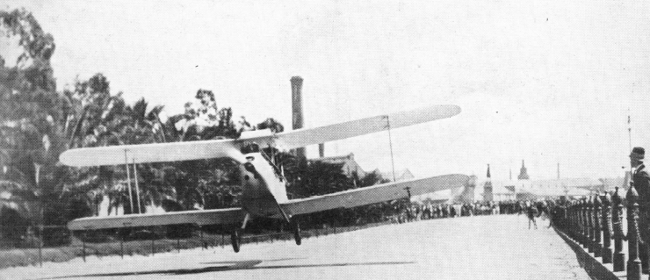
Major Miller taking off in his Moth from the esplanade at Cape Town.
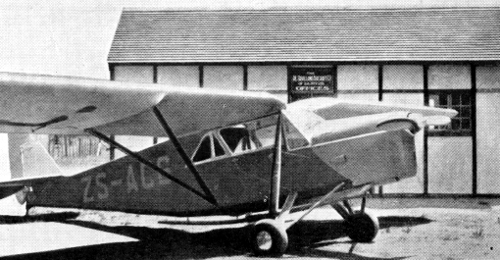
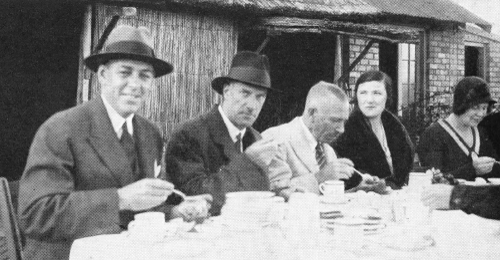
Early days. Left, a Puss Moth outside the offices of de Havilland South Africa at Baragwanath in 1930. In 1932 Captain Geoffrey de Havilland and Mr. C. C. Walker visited the South African company; a contemporary snap shows (left to right} Mr. Rod Douglas, Capt. de Havilland, Mr. Walker, Mrs. Noel Gilfillan, Mrs. Douglas.
With its sales talk lined up and its products already a household word, the new Company in 1930 also found itself equipped with a wealth of minted experience to guide its course. In effect the Company had already been blooded when it went into action. The South Africans on its Board were there by dint of hard work and planning; the Company itself had evolved out of a series of incidents that, far from being accidental, seemed to have developed inevitably towards its creation. Flying club activities in South Africa had started in the middle 'twenties with the formation of the JLPC, with headquarters and airfield at Baragwanath, on the southern outskirts of Johannesburg. All the famous pilots of the day landed at Baragwanath; here the first great air rallies were held in conjunction with the South African Air Force. The aerodrome was the cradle of the Union's lustily growing civil aviation baby, the breeding ground of future pilots. Rod Douglas, with a few flying friends of the first Great War had started the Club going, but as more and more pilots were trained, difficulties arose on the technical side with regard to service and aircraft spares. Unfortunately the de Havilland Agency of that day was not keeping up with the pace: the flying business was still regarded as hazardous and not everyone was prepared to take long chances. So Douglas (then Hon. Club Capt., JLPC), G. S. Haggie and S. S. Halse (instructor at Baragwanath) started a small company on the side, Aeros (Pty.) Ltd., hoping to come to an agreement with the de Havilland Agent, whereby any additional capital would be used for carrying a larger range of spares, which would be offered to the biggest buyers, such as the JLPC, at a lower price. But high hopes and negotiations failed to materialise and, undaunted, Aeros took over the Avro Avian Agency, importing two Avians and persuading the S.A.A.F. to order 20 for its Elementary Flying Training programme.
de Havilland sat up. From England swiftly and unannounced came Sales Manager F. E. N. St. Barbe to take stock of the position. He saw, summed up, and "started in" on Aeros. Within a matter of weeks Aeros had relinquished the Avro Agency in favour of the de Havilland Agency, and under the terms of the new agency agreement, made two farreaching appointments. Jack Davison was brought in as full-time Secretary and S. T. E. Stanley People came out from England to be Service Manager. The latter played an unforgettable part for ten crowded years in maintaining and still further increasing the great reputation of de Havilland products in South Africa. Popular, able, industrious and studious, he was a fine leader of civil ground engineers, rendering invaluable service to aviation in the country, until a great career was tragically cut short when both Mr. and Mrs. (May) People were killed in a flying accident on May 4, 1940.
de Havilland sat up. From England swiftly and unannounced came Sales Manager F. E. N. St. Barbe to take stock of the position. He saw, summed up, and "started in" on Aeros. Within a matter of weeks Aeros had relinquished the Avro Agency in favour of the de Havilland Agency, and under the terms of the new agency agreement, made two farreaching appointments. Jack Davison was brought in as full-time Secretary and S. T. E. Stanley People came out from England to be Service Manager. The latter played an unforgettable part for ten crowded years in maintaining and still further increasing the great reputation of de Havilland products in South Africa. Popular, able, industrious and studious, he was a fine leader of civil ground engineers, rendering invaluable service to aviation in the country, until a great career was tragically cut short when both Mr. and Mrs. (May) People were killed in a flying accident on May 4, 1940.
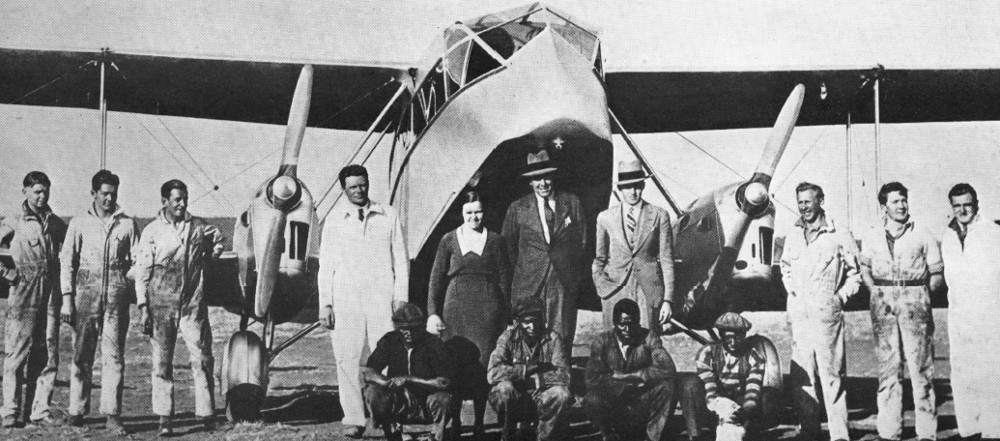
1933. The first Dragon to be imported into South Africa, and the entire staff of D.H. South Africa at the time Left to right:
H Sharman (now an engineer in Salisbury), D. Raubenheimer (now a Senior Pilot of South African Airways), W. Gillman, S. T. E. People, Miss Normington (typist), Rod Douglas, Jack Davison, C. F. Strecker, W. Magee, N. H. Phillipps (who handled the Company's stores until 1946).
In front of the standing row are four African handymen who served the Company at that time.
H Sharman (now an engineer in Salisbury), D. Raubenheimer (now a Senior Pilot of South African Airways), W. Gillman, S. T. E. People, Miss Normington (typist), Rod Douglas, Jack Davison, C. F. Strecker, W. Magee, N. H. Phillipps (who handled the Company's stores until 1946).
In front of the standing row are four African handymen who served the Company at that time.
While the new de Havilland Agency flourished beyond even the brightest expectations, it was destined to be short-lived. Enormous expansion in aviation was taking place in England, and it was abundantly clear that Aeros were inadequately equipped financially to cope with the similar expansion which was sure to follow in South Africa, de Havilland were persuaded to buy out Aeros six months later, and in place of that company to form the de Havilland Aircraft Company of South Africa (Pty.) Limited. Workshops and a servicing agreement were right to hand. Through an affiliation made with the JLPC, from which Rod Douglas had resigned to take his place on the new Company's Board, the Club handed over its workshops to the Company which in turn undertook to do the Club's servicing at a fixed rate per flying hour. The rebuilding of crashed aircraft was to be done under separate contract. What was tantamount to a unique partnership grew from strength to strength as the scope of the South African Company widened. Within three months of operation de Havilland South Africa had imported no fewer than six Puss Moths, with a seventh on order. Enquiries for aircraft were pouring in from all parts of Southern Africa. Optimism ran high.
Further attempts were being made on the London-Cape record. Lt. Pat Murdoch's 1928 time of 13 days had been lowered in 1930 by R. F. Caspareuthus to 8 1/2 days in a Puss Moth, only to be beaten early in 1931 by Commander Glen Kidston using a high-powered Lockheed Orion, with a time of 6 days, 10 hours. This started the fashion of measuring times to the nearest minute and also using the machinery of the Rojfal Aero Club for official starting, time-keeping and clocking-in at Cape Town. The talk about this flight had not yet died down before Gordon Store and Miss Peggy Salaman, flying a Puss Moth, reduced the time to 5 days, 6 hours, 40 minutes. The keynote of the talk all over the world was - de Havilland products have done it again! The clubs and flying companies reported increased demands for instruction and private charter — the Register of Private Owners continued to expand.
Growing pains there had always been, and by diagnosis and remedy, effort and more effort, they were cured. The early 'thirties were times of difficulty in world trade which hit de Havilland at home and overseas, including Southern Africa, adding to technical burdens.
Directors, staff and friends of the Company threw in their weight to assist in the workshops and on the tarmac, acted as salesmen and thought up brainwaves to increase revenue — one was the installation of an electric plant at Baragwanath to popularise night-flying trips, and over and above that the Company sold electricity to the Club. Flying hours gradually built up, with still those occasional great flights that thrilled everyone concerned. Bert Hinkler and the Mollisons went on to break new records with Puss Moths.
Capt. de Havilland, accompanied by Mr. C. C. Walker, visited the Union at the suggestion of the South African subsidiary, and their talks with officials, public and Press helped tremendously. There was widespread enthusiasm at Capt. de Havilland's announcement of the Leopard Moth - a 3-seater with two passenger seats behind the pilot — which he had designed. Biggest headlines, however, were made on that 1932 visit by the news release of the Fox Moth, designed to give commercial operators an entirely new "high "in payload in relation to horse-power. Commercial aviation was on its way. Interest in the arrival of the first Fox Moth in South Africa was further stimulated by a new Speed Model Fox Moth winning the King's Cup Air Race, and before the end of the year the Company had started to make steady profits, never to look back again in its career.
Creative is the one word that describes the course on which de Havilland South Africa then embarked. Fox Moths, Dragons, Leopard Moths, Hornet Moths and Dragon Rapides were captivating the public fancy. The territory for sales expanded to Kenya, Uganda and Tanganyika. Concurrently with the development of the Rand Airport plans were put into operation to treble the size of the aerodrome at Baragwanath. Tempting offers to move the Company to the Rand Airport failed — Baragwanath was too firmly part of its tradition and history.
Highlights of the thriving 'thirties boosted belief in aviation and confirmed the Company's destined role in Southern Africa:
1933 gave another great lift to de Havilland products when news flashed round the world that Capt. Geoffrey de Havilland had won the King's Cup Air Race. It was a universally popular win, with a famous pilot flying a Leopard Moth designed by himself and manufactured by the Company that bore his name.
1934 saw great territorial expansion. Two new subsidiaries of the de Havilland Aircraft Company of South Africa came into being — the one was founded in Southern Rhodesia, the other, African Air Transport Limited (A. A.T.), was purchased by the Company in the Union. A Sales and Service Organisation was simultaneously started at Durban, Natal.
1935-1939 brought further developments in the commercial field and thrust de Havillands South Africa to the fore in the field of air training. The Gipsy Six engine, fitted in a variety of aircraft, took over the racing business down Africa, de Havilland still led the field, setting the pace for commercial and military training, spurring on private and unsubsidised flying.
In 1935 Jack Davison took over the Managing Directorship of the Rhodesian Company and C. V. Giddy was appointed Secretary of the South African Company.
Further attempts were being made on the London-Cape record. Lt. Pat Murdoch's 1928 time of 13 days had been lowered in 1930 by R. F. Caspareuthus to 8 1/2 days in a Puss Moth, only to be beaten early in 1931 by Commander Glen Kidston using a high-powered Lockheed Orion, with a time of 6 days, 10 hours. This started the fashion of measuring times to the nearest minute and also using the machinery of the Rojfal Aero Club for official starting, time-keeping and clocking-in at Cape Town. The talk about this flight had not yet died down before Gordon Store and Miss Peggy Salaman, flying a Puss Moth, reduced the time to 5 days, 6 hours, 40 minutes. The keynote of the talk all over the world was - de Havilland products have done it again! The clubs and flying companies reported increased demands for instruction and private charter — the Register of Private Owners continued to expand.
Growing pains there had always been, and by diagnosis and remedy, effort and more effort, they were cured. The early 'thirties were times of difficulty in world trade which hit de Havilland at home and overseas, including Southern Africa, adding to technical burdens.
Directors, staff and friends of the Company threw in their weight to assist in the workshops and on the tarmac, acted as salesmen and thought up brainwaves to increase revenue — one was the installation of an electric plant at Baragwanath to popularise night-flying trips, and over and above that the Company sold electricity to the Club. Flying hours gradually built up, with still those occasional great flights that thrilled everyone concerned. Bert Hinkler and the Mollisons went on to break new records with Puss Moths.
Capt. de Havilland, accompanied by Mr. C. C. Walker, visited the Union at the suggestion of the South African subsidiary, and their talks with officials, public and Press helped tremendously. There was widespread enthusiasm at Capt. de Havilland's announcement of the Leopard Moth - a 3-seater with two passenger seats behind the pilot — which he had designed. Biggest headlines, however, were made on that 1932 visit by the news release of the Fox Moth, designed to give commercial operators an entirely new "high "in payload in relation to horse-power. Commercial aviation was on its way. Interest in the arrival of the first Fox Moth in South Africa was further stimulated by a new Speed Model Fox Moth winning the King's Cup Air Race, and before the end of the year the Company had started to make steady profits, never to look back again in its career.
Creative is the one word that describes the course on which de Havilland South Africa then embarked. Fox Moths, Dragons, Leopard Moths, Hornet Moths and Dragon Rapides were captivating the public fancy. The territory for sales expanded to Kenya, Uganda and Tanganyika. Concurrently with the development of the Rand Airport plans were put into operation to treble the size of the aerodrome at Baragwanath. Tempting offers to move the Company to the Rand Airport failed — Baragwanath was too firmly part of its tradition and history.
Highlights of the thriving 'thirties boosted belief in aviation and confirmed the Company's destined role in Southern Africa:
1933 gave another great lift to de Havilland products when news flashed round the world that Capt. Geoffrey de Havilland had won the King's Cup Air Race. It was a universally popular win, with a famous pilot flying a Leopard Moth designed by himself and manufactured by the Company that bore his name.
1934 saw great territorial expansion. Two new subsidiaries of the de Havilland Aircraft Company of South Africa came into being — the one was founded in Southern Rhodesia, the other, African Air Transport Limited (A. A.T.), was purchased by the Company in the Union. A Sales and Service Organisation was simultaneously started at Durban, Natal.
1935-1939 brought further developments in the commercial field and thrust de Havillands South Africa to the fore in the field of air training. The Gipsy Six engine, fitted in a variety of aircraft, took over the racing business down Africa, de Havilland still led the field, setting the pace for commercial and military training, spurring on private and unsubsidised flying.
In 1935 Jack Davison took over the Managing Directorship of the Rhodesian Company and C. V. Giddy was appointed Secretary of the South African Company.
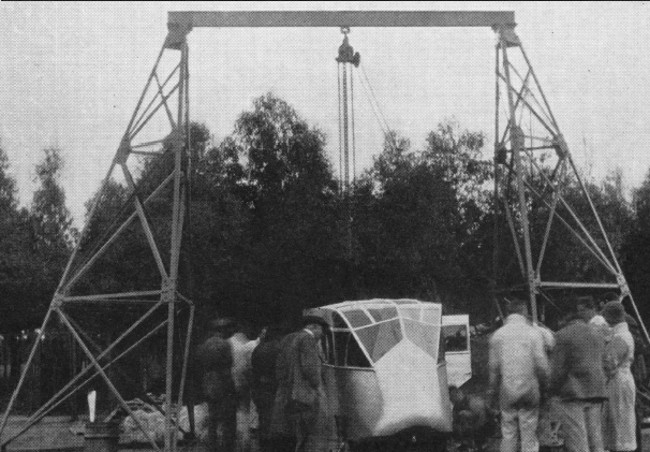
Growth of a Dragon. Uncrating, and the start of the assembly, of the first Dragon to arrive in South Africa in 1933.
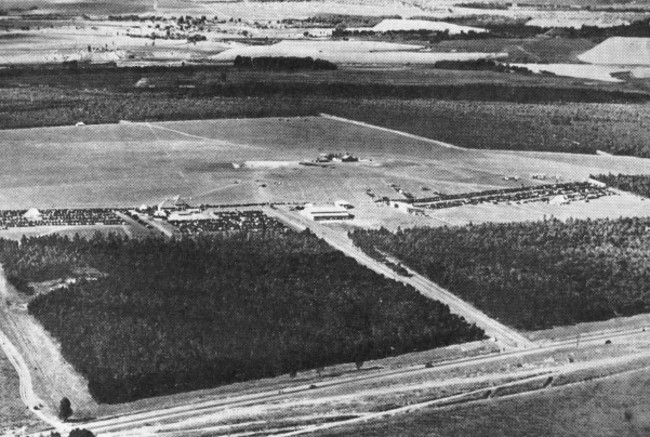
Where it all started and carries on to this day—Baragwanath aerodrome. This photograph was taken in 1935, on the occasion of an air display celebrating the enlargement of the aerodrome and the opening of new quarters for D.H. South Africa and the Johannesburg Light Plane Club. During the display the old premises of both organisations were "bombed out of existence". . . .
Rod Douglas returned from a visit to England where prodigious expansion was taking place in the parent Company, with that country aware that war with Hitler's Germany was only a matter of time. The fine new military trainer, the Tiger Moth, had been developed and from then on the Company's main role in the Union was to develop flying training facilities as quickly and extensively as possible. The three companies of the local group, other flying companies, flying clubs and the Press were all brought into line by very necessary "scare" tactics. A scheme formulated by the Company for Flying Bursaries at Baragwanath spread to other centres. The Rhodesian Company worked on the same lines, starting a Travelling Flying School and co-operating with the Department of Civil Aviation and Defence in flying training programmes. Tiger Moths were in great demand. It was not surprising that 1938 proved to be the peak year for the sale of de Havilland products in South Africa. So great was expansion that hangar accommodation at Baragwanath was doubled to cope with increased business.
In September Mr. St. Barbe paid his second visit to South Africa — what a change in conditions from 1929! And a full Board Meeting with representatives from all the subsidiaries was held to celebrate this phenomenal progress with him. Portuguese East Africa was included in the Company's new territorial limits — and it proved to be one of the staunchest and best of associations. The wisdom of the policy of creating two subsidiary companies and purchasing a third became clear in 1939, when all were operating at a profit and doing work of great national importance in the Union, Rhodesia and South-West Africa by turning out pupil pilots and training ground engineers. At the outbreak of war on September 3, de Havilland enterprises in South Africa could best be summed up as follows:
1. A large measure of credit for the success of the JLPC and the activities at Baragwanath, including a service contract for the maintenance of their fleet which had been successfully operated for nine years.
2. The existence of a large number of privately owned aircraft distributed all round South Africa and flown by well-trained pilots.
3. Successful flying training establishments at Durban, Pietermaritzburg, Cape Town, Kimberley, Bloemfontein and in South West Africa, and some credit due for the success of the Pretoria School and the Technical Training College enterprise at Germiston. In Rhodesia an excellent Sales and Service and a flying training organisation at Salisbury, a successful Travelling Flying School and a good measure of credit for the success of the Flying Club at Bulawayo.
In addition, Dragon Rapides were doing great work for their owners and flying on daily schedules all over Kenya, Uganda, Tanganyika, the Belgian Congo, the two Rhodesias, Nyasaland, Portuguese West Africa and Portuguese East Africa. In South Africa and South West Africa de Havilland products, mostly Leopard and Fox Moths, were handling 90 per cent, of the private charter work offering. What a legacy of equipment and trained personnel for the Government concerned to build on in the war against Hitler! Trace the activities of these pilots and all the ground engineers throughout the War, and the story makes even prouder telling. Rod Douglas was called up and remained in service with the South African Air Force from September 9, 1939, to November, 1944. On the staff of the Director- General of Air Services in Pretoria, he had the satisfaction of seeing Tiger Moths ordered almost exclusively for S.A.A.F. training. Jack Davison served with the Southern Rhodesian Air Force from September, 1939, to November, 1945, part of which time he served in England as Liaison Officer of the Southern Rhodesian Government. In 1940 the Government took over the Company's assets and activities for the duration; similarly the Rhodesian Company was taken over in 1939 by the Rhodesian Government and its personnel absorbed into the Rhodesian Air Force. The A.A.T. was put into cold storage for the duration.
The post-war policy of The de Havilland Aircraft Company (which had increased its scope and prestige enormously during the war), was being laid by 1945 — no longer would it be trading in light aircraft, its interest in club and school flying activities was a thing of the past, so its need for an independent servicing associate company in South Africa fell away, de Havilland South Africa was to become more closely a part of the parent Company — which in due course bought all the locally held shares. The parent Company also decided that there was no need to go beyond the retention of the two executives, Rod Douglas and Jack Davison as directors.
In September Mr. St. Barbe paid his second visit to South Africa — what a change in conditions from 1929! And a full Board Meeting with representatives from all the subsidiaries was held to celebrate this phenomenal progress with him. Portuguese East Africa was included in the Company's new territorial limits — and it proved to be one of the staunchest and best of associations. The wisdom of the policy of creating two subsidiary companies and purchasing a third became clear in 1939, when all were operating at a profit and doing work of great national importance in the Union, Rhodesia and South-West Africa by turning out pupil pilots and training ground engineers. At the outbreak of war on September 3, de Havilland enterprises in South Africa could best be summed up as follows:
1. A large measure of credit for the success of the JLPC and the activities at Baragwanath, including a service contract for the maintenance of their fleet which had been successfully operated for nine years.
2. The existence of a large number of privately owned aircraft distributed all round South Africa and flown by well-trained pilots.
3. Successful flying training establishments at Durban, Pietermaritzburg, Cape Town, Kimberley, Bloemfontein and in South West Africa, and some credit due for the success of the Pretoria School and the Technical Training College enterprise at Germiston. In Rhodesia an excellent Sales and Service and a flying training organisation at Salisbury, a successful Travelling Flying School and a good measure of credit for the success of the Flying Club at Bulawayo.
In addition, Dragon Rapides were doing great work for their owners and flying on daily schedules all over Kenya, Uganda, Tanganyika, the Belgian Congo, the two Rhodesias, Nyasaland, Portuguese West Africa and Portuguese East Africa. In South Africa and South West Africa de Havilland products, mostly Leopard and Fox Moths, were handling 90 per cent, of the private charter work offering. What a legacy of equipment and trained personnel for the Government concerned to build on in the war against Hitler! Trace the activities of these pilots and all the ground engineers throughout the War, and the story makes even prouder telling. Rod Douglas was called up and remained in service with the South African Air Force from September 9, 1939, to November, 1944. On the staff of the Director- General of Air Services in Pretoria, he had the satisfaction of seeing Tiger Moths ordered almost exclusively for S.A.A.F. training. Jack Davison served with the Southern Rhodesian Air Force from September, 1939, to November, 1945, part of which time he served in England as Liaison Officer of the Southern Rhodesian Government. In 1940 the Government took over the Company's assets and activities for the duration; similarly the Rhodesian Company was taken over in 1939 by the Rhodesian Government and its personnel absorbed into the Rhodesian Air Force. The A.A.T. was put into cold storage for the duration.
The post-war policy of The de Havilland Aircraft Company (which had increased its scope and prestige enormously during the war), was being laid by 1945 — no longer would it be trading in light aircraft, its interest in club and school flying activities was a thing of the past, so its need for an independent servicing associate company in South Africa fell away, de Havilland South Africa was to become more closely a part of the parent Company — which in due course bought all the locally held shares. The parent Company also decided that there was no need to go beyond the retention of the two executives, Rod Douglas and Jack Davison as directors.
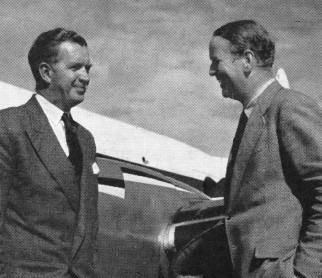
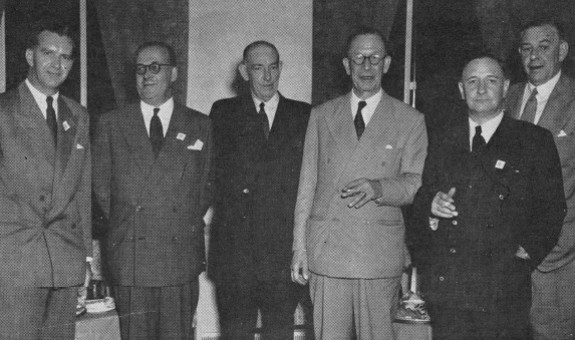
Mr. Jack Davison with Mr. John Cunningham at Hatfield in the autumn of 1953, when the former made one of his regular visits to the parent Company in England.
In December of 1952, Mr. W. E. Nixon went to Johannesburg and is here seen on the occasion of a re-union of pre-war directors of the South African company. Unfortunately Mr. H. K. Hull, who had been a director until near that time, was unable to join the gathering, but Messrs. Jack Davison, H. D. Evans, Gordon Douglas, W. E. Nixon, N. H. Gilfillan and Rod Douglas were there and the picture shows them, in that order, left to right.
A great part had been played by the South African Company's Board of Directors during 1930-1941, in particular by N. H. Gilfillan, Gordon Douglas, H. D. Evans and H. K. Hull. And in the golden annals of the Company there must also be recorded in appreciation of their sterling contributions to its progress, the names of R. B. Sinclair, auditor of the Company since its inception; G. S. Haggie; H. R. Hoar; P. E. Hunt; Sir E. Lucas Guest and the Hon. John Stuart.
The new Board of the Company consisted of Rod Douglas (Chairman), Jack Davison (Managing Director), Sir Geoffrey de Havilland and A. S. Butler. Mr. W. E. Nixon and Mr. F. E. N. St. Barbe were appointed in 1946 and Mr. Butler resigned in 1950. Mr. F. T. Hearle was appointed in 1951 and that is how the Board is constituted at the present time.
First in the field after the switchover from war-time to peace-time production was the de Havilland Dove, and this aircraft was taken up eagerly by East African Airways, Central African Airways, South African Airways, DETA, Sabena and West African Airways, while private companies helped to swell the order book. The S.A.A.F. ordered nine Devon#, the Dove's military counterpart. Another post-war development, the Heron — a luxury four-engined commercial and private owner type — is proving popular in Southern Africa. Chipmunks found their way into the country, followed by another Canadian venture — the Beaver, the agricultural version of which is expected to find a ready market in Southern Africa. Again, the London-Cape record was broken in 1947 by S/Ldr. H. B. Martin, flying a Mosquito, with the spectacular time of 21 hours 29 minutes. Remember Dickie Bentley's 1927 solo record of 28 days. From that to jet propulsion, ushered into South Africa with the D.H. Vampires ordered in 1950 by the South African Air Force. In July, 1951, the Mosquito record on the London-Johannesburg section of the run was lowered by a Comet 1 flown by Capt. A. M. Majendie of B.O.A.C.; flying time: 17 hours, 31 minutes. The triumphs and the tragedy of the Comet are common knowledge, its final chapters are still to be told, but faith in its come-back is firmly held by South Africans who were proud to fly it and fly in it.
At the 21st Annual General Meeting in December, 1951, the Chair was occupied by none other than Mr. W. E. Nixon, who had come to South Africa for the first time and who we were very pleased to welcome with Mrs. Nixon.
The Company's Technical section still operates from Baragwanath Aerodrome under Jac. Lorentz who joined the Company as Technical Sales Manager in 1951. He has with him on the aircraft maintenance side, Denys Mail, who started his apprenticeship in the Aviation Industry under "Pops" People, and except for the War and a short period thereafter has been with the Company and its subsidiaries ever since. On the Engine side we have F. E. G. Quinn, who came out from the parent Company in 1952. Though many engineers come and go, as it is the Company's policy to be thoroughly up to date with the latest aircraft, engine and propeller developments, the other general servicing staff which covers the area in Africa south of the Equator as well as Lagos in West Africa, must perforce change periodically. There are six of them coming and going all the time.
In 1953 the Parent Directors were persuaded to allow Mr. A. J. Brant to tour through the territories administered by the South African company and to advise whether the technical services were in accordance with the plan envisaged by him in his world-wide Service Department set-up. He was able to offer constructive and useful suggestions which have been put into operation and which are working admirably. Mrs. Brant accompanied him on his tour and he was able to meet and acquaint himself with organisations which previously had been but names to him.
The new Board of the Company consisted of Rod Douglas (Chairman), Jack Davison (Managing Director), Sir Geoffrey de Havilland and A. S. Butler. Mr. W. E. Nixon and Mr. F. E. N. St. Barbe were appointed in 1946 and Mr. Butler resigned in 1950. Mr. F. T. Hearle was appointed in 1951 and that is how the Board is constituted at the present time.
First in the field after the switchover from war-time to peace-time production was the de Havilland Dove, and this aircraft was taken up eagerly by East African Airways, Central African Airways, South African Airways, DETA, Sabena and West African Airways, while private companies helped to swell the order book. The S.A.A.F. ordered nine Devon#, the Dove's military counterpart. Another post-war development, the Heron — a luxury four-engined commercial and private owner type — is proving popular in Southern Africa. Chipmunks found their way into the country, followed by another Canadian venture — the Beaver, the agricultural version of which is expected to find a ready market in Southern Africa. Again, the London-Cape record was broken in 1947 by S/Ldr. H. B. Martin, flying a Mosquito, with the spectacular time of 21 hours 29 minutes. Remember Dickie Bentley's 1927 solo record of 28 days. From that to jet propulsion, ushered into South Africa with the D.H. Vampires ordered in 1950 by the South African Air Force. In July, 1951, the Mosquito record on the London-Johannesburg section of the run was lowered by a Comet 1 flown by Capt. A. M. Majendie of B.O.A.C.; flying time: 17 hours, 31 minutes. The triumphs and the tragedy of the Comet are common knowledge, its final chapters are still to be told, but faith in its come-back is firmly held by South Africans who were proud to fly it and fly in it.
At the 21st Annual General Meeting in December, 1951, the Chair was occupied by none other than Mr. W. E. Nixon, who had come to South Africa for the first time and who we were very pleased to welcome with Mrs. Nixon.
The Company's Technical section still operates from Baragwanath Aerodrome under Jac. Lorentz who joined the Company as Technical Sales Manager in 1951. He has with him on the aircraft maintenance side, Denys Mail, who started his apprenticeship in the Aviation Industry under "Pops" People, and except for the War and a short period thereafter has been with the Company and its subsidiaries ever since. On the Engine side we have F. E. G. Quinn, who came out from the parent Company in 1952. Though many engineers come and go, as it is the Company's policy to be thoroughly up to date with the latest aircraft, engine and propeller developments, the other general servicing staff which covers the area in Africa south of the Equator as well as Lagos in West Africa, must perforce change periodically. There are six of them coming and going all the time.
In 1953 the Parent Directors were persuaded to allow Mr. A. J. Brant to tour through the territories administered by the South African company and to advise whether the technical services were in accordance with the plan envisaged by him in his world-wide Service Department set-up. He was able to offer constructive and useful suggestions which have been put into operation and which are working admirably. Mrs. Brant accompanied him on his tour and he was able to meet and acquaint himself with organisations which previously had been but names to him.
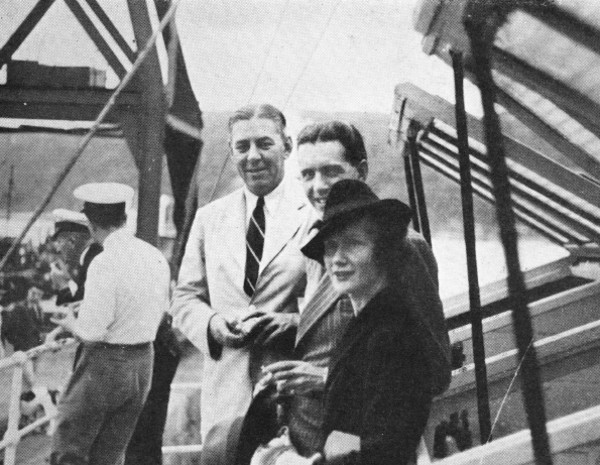
The Ascanius farewell—Mrs. St. Barbe, with Messrs. Rod Douglas and Jack Davison on board s.s. Ascanius at Durban at the end of the visit paid by Mr. and Mrs. St. Barbe to D.H. South Africa in 1938.
The Technical Headquarters is within six hours' flying of our furthest point and the speed and efficiency with which technical service is provided throughout the Company's territories has maintained its boast of unsurpassed after-sales service.
Stock control and stores were handled practically from the Company's inception until 1946 by Noel Phillipps, who incidentally "kept the Company's flag flying" during the War when all the executives were on active service. His place was taken by R. A. Parrot for six years when he left to join de Havillands in Canada. Since his departure the section is being handled by T. J. Maguire, with his provider of every requirement, W. A. Rundle.
This year the Company added further to its staff— Allan Bell, who handles aircraft sales and is presently flying Beavers through all sorts of African conditions including locusts! In the Head Office at Maritime House we have the two Betty's — Mace and Dall — who have been there for eight years and always offer a de Havilland welcome to any visitors to Johannesburg.
The only director who had not previously visited the territory was Mr. F. T. Hearle; however, in February, 1954, he was persuaded to have a look at the South African organisation, and we were happy to have the Chairman of the de Havilland Company in England occupy our Chair at a meeting held in Johannesburg. Mr. Hearle was accompanied on his visit by his sister, Mrs. M. White.
Briefly, at the completion of its first quarter of a century, de Havilland South Africa pauses to look back over the years of battle and achievement, to smile at the good old days, the tough times, to remember friends and allies, the matching of wits against diehards and the Fates, the taking of chances in "flying type" style. Remember the laughs, too — the D.H. Dragon Party at Baragwanath, when the Ladies' Committee looked after the catering and the Company looked after the drinks — wherefore the most glowing Press reports appeared on the Dragon's debut. High times with the early pioneers of the skies; the "Ascanius" farewell to the St. Barbes at Durban just prior to the war — but even as they talk, those stalwarts Rod Douglas and Jack Davison, a little grey now at the temples, but with fire and enthusiasm undimmed, have their eyes on the next quarter of a century with its plans for the Company's progress. From the walls in the Chairman's office in Maritime House, Johannesburg, look the original five men who inspired and have maintained that lasting belief in de Havilland products: Sir Geoffrey de Havilland, F. T. Hearle, W. E. Nixon, C. C. Walker and F. E. N. St. Barbe. From the bond between that team and the South African side, has sprung the great de Havilland tradition that is part of South Africa's aviation history.
Stock control and stores were handled practically from the Company's inception until 1946 by Noel Phillipps, who incidentally "kept the Company's flag flying" during the War when all the executives were on active service. His place was taken by R. A. Parrot for six years when he left to join de Havillands in Canada. Since his departure the section is being handled by T. J. Maguire, with his provider of every requirement, W. A. Rundle.
This year the Company added further to its staff— Allan Bell, who handles aircraft sales and is presently flying Beavers through all sorts of African conditions including locusts! In the Head Office at Maritime House we have the two Betty's — Mace and Dall — who have been there for eight years and always offer a de Havilland welcome to any visitors to Johannesburg.
The only director who had not previously visited the territory was Mr. F. T. Hearle; however, in February, 1954, he was persuaded to have a look at the South African organisation, and we were happy to have the Chairman of the de Havilland Company in England occupy our Chair at a meeting held in Johannesburg. Mr. Hearle was accompanied on his visit by his sister, Mrs. M. White.
Briefly, at the completion of its first quarter of a century, de Havilland South Africa pauses to look back over the years of battle and achievement, to smile at the good old days, the tough times, to remember friends and allies, the matching of wits against diehards and the Fates, the taking of chances in "flying type" style. Remember the laughs, too — the D.H. Dragon Party at Baragwanath, when the Ladies' Committee looked after the catering and the Company looked after the drinks — wherefore the most glowing Press reports appeared on the Dragon's debut. High times with the early pioneers of the skies; the "Ascanius" farewell to the St. Barbes at Durban just prior to the war — but even as they talk, those stalwarts Rod Douglas and Jack Davison, a little grey now at the temples, but with fire and enthusiasm undimmed, have their eyes on the next quarter of a century with its plans for the Company's progress. From the walls in the Chairman's office in Maritime House, Johannesburg, look the original five men who inspired and have maintained that lasting belief in de Havilland products: Sir Geoffrey de Havilland, F. T. Hearle, W. E. Nixon, C. C. Walker and F. E. N. St. Barbe. From the bond between that team and the South African side, has sprung the great de Havilland tradition that is part of South Africa's aviation history.
The Staff of the de Havilland Aircraft Company of South Africa (Pty.) Limited
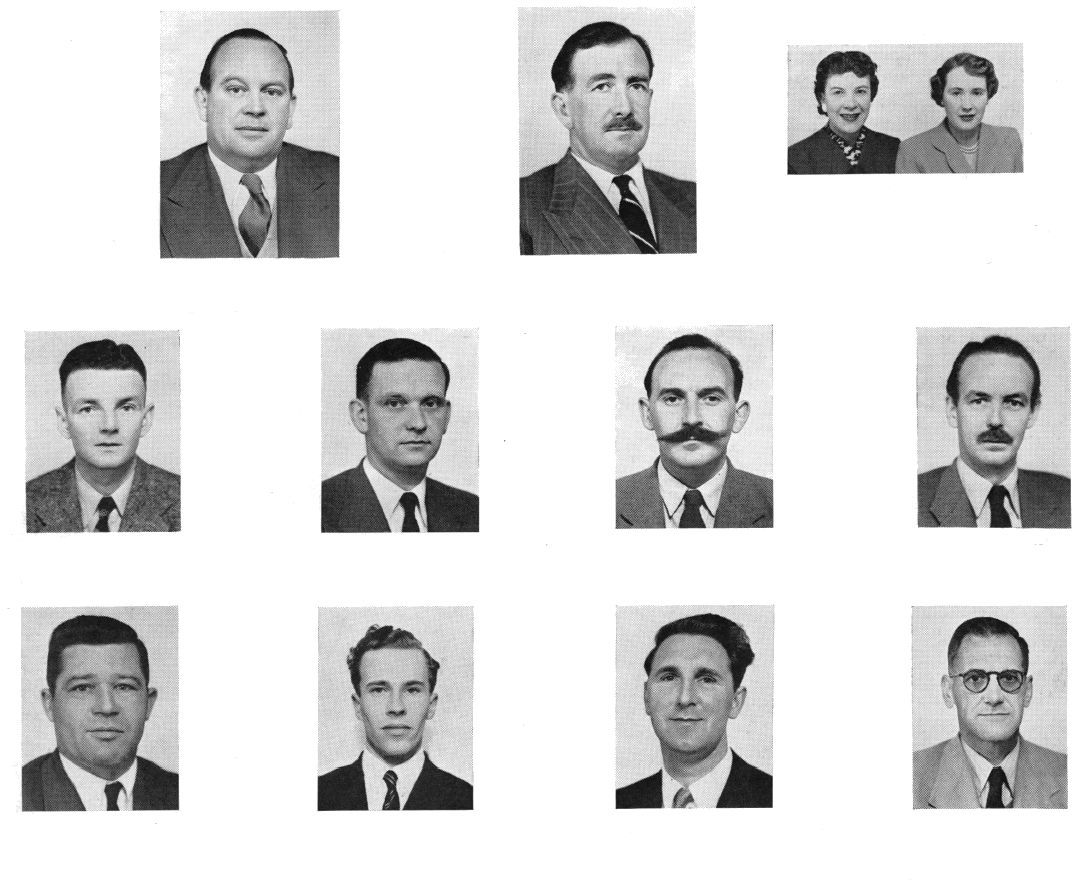
The article below is contained in the "A Scrap Book of de Havilland Aircraft collected by Denys Douglas Mail" and housed in the archives of The South African Airways Museum Society .
Mr. J. Lorentz
Technical Sales Manager
Technical Sales Manager
Mr. A. L. Bell
Aircraft Sales Manager
Aircraft Sales Manager
The "Two Bettys"
Mrs. Elizabeth Mace
Secretary to Mr. J. Davison
Mrs. Betsy Dall
Assistant to Mrs. Mace
Mrs. Elizabeth Mace
Secretary to Mr. J. Davison
Mrs. Betsy Dall
Assistant to Mrs. Mace
Mr. D. D. Mail
Headquarters Staff
Aircraft Division
Headquarters Staff
Aircraft Division
Mr. F. E. G. Quinn
Headquarters Staff
Engine Division
Headquarters Staff
Engine Division
Mr. L. G. Holland
Field Service
Aircraft Division
Field Service
Aircraft Division
Mr. B. Dones
Headquarters Staff
Aircraft Division
Headquarters Staff
Aircraft Division
Mr. E. R. Walsh
Field Service
Aircraft Division
Field Service
Aircraft Division
Mr. Bruce Bosher
D.H. Engine Company
Representative
D.H. Engine Company
Representative
Mr. T. J. Maguire
Stores Controller
Stores Controller
Mr. W. A. Rundle
Stores Assistant and
''Universal Provider.''
Stores Assistant and
''Universal Provider.''